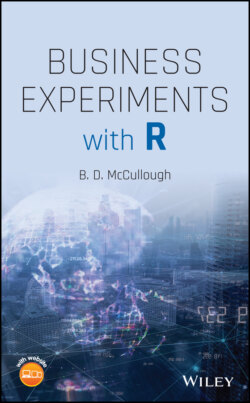Читать книгу Business Experiments with R - B. D. McCullough - Страница 42
Section 1.4 “What Is a Business Experiment?”
Оглавление• The financial services example is based on Watson‐Hemphill and Kastle (2012).
• The Progressive Insurance example comes from Chapter 22 of Holland and Cochran (2005).
• The Anheuser‐Busch example comes from Ackoff (1978).
• The number of conditions necessary to establish causality varies from discipline to discipline and even author to author. For example, the epidemiologist Hill (1965) gave nine rules. We stick with just three.
• While observational data can be useful, they are no substitute for an experiment (if an experiment can be conducted!):
But even if done perfectly, an observational study can only approach, but never reach, the credibility of randomization in assuring that there is no missing third variable that accounts for the differences observed in the experimental outcome. (Wainer, 2016, p. 48)
• The book by Schrage (2014) is entertaining and describes numerous business experiments; most of these are small, inexpensive experiments. The book by Holland and Cochran (2005), which is written for laymen, describes several larger, more complicated experiments. The article by Ganguly and Euchner (2018) describes the approach of the Goodyear Tire Company to experimentation and gives many interesting examples, including one where they conducted an experiment to determine whether tire‐pressure monitoring equipment could generate more than enough savings to pay for the monitoring equipment by reducing roadside breakdowns of tractor‐trailers. It is worthwhile to read materials such as these, for it is important for the novice experimenter to develop an idea of what has been done and what is possible.
• The idea that small sample sizes, small effect sizes, and lots of noise can lead to false positives and even sign reversals (truly positive coefficients being estimated as negative) is discussed in terms about as nontechnical as possible in Gelman and Carlin (2014), but you'll have to know what “power” is to follow the argument, so maybe you should wait until after Chapter 2 to read it.
